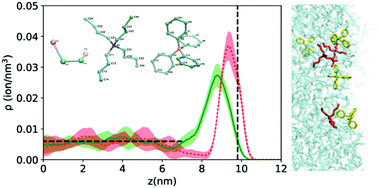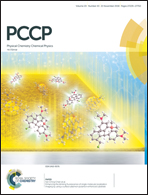Debye screening, overscreening and specific adsorption in solutions of organic ions†
Abstract
Tetrabutylammonium (TBA) and tetraphenylborate (TPB) ions dissolved in dichloroethane (DCE) are widely used in electrochemistry of liquid–liquid interfaces. Unlike alkali halide solutions in water, TBA–TPB–DCE solutions feature large organic ions and a solvent with a dielectric constant almost one order of magnitude lower than that of water. This is expected to dramatically amplify the impact of ionic correlations in the properties of the solution. Here we report atomistic simulations of TBA–TPB–DCE solutions and analyze ion correlations, clustering, and charge screening effects. We target concentrations in the range of 0.01–0.25 molal (m), hence exploring concentration regimes typical for many experimental investigations. We show that the transition from monotonic to oscillatory decay of the charge density, which signals the onset of strong ion correlations, takes place in this concentration interval, leading to overscreening effects. Furthermore, we investigate the distribution and adsorption of ions at the DCE–air interface. Unlike what is observed for small inorganic ions in water at similar concentrations, we find that TPB and TBA ions accumulate near the DCE surface, resulting in significant interfacial clustering and adsorption at concentrations ∼0.25 m. TPB ions adsorb more strongly leading to free energy wells of ∼1–2 kBT. The adsorption modifies significantly the electrostatic potential of the DCE–air interface, which undergoes a shift of 0.2 V in going from pure DCE to TBA–TPB–DCE solutions at 0.25 m.



 Please wait while we load your content...
Please wait while we load your content...